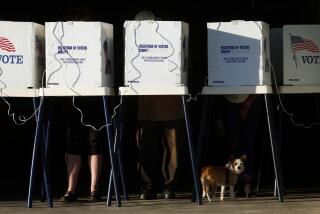Goldberg: Nate Silver’s numbers racket
In the last week or so, an intense kerfuffle broke out over the poll-prognosticator Nate Silver and his blog at the New York Times, FiveThirtyEight. Silver, a statistician, has been predicting a decisive Obama victory for a very long time, based on his very complicated statistical model, which very, very few of his fans or detractors understand.
On any given day, Silver might announce that — given the new polling data — “the model” now finds that the president has an 86.3% chance of winning. Not 86.4%, you fools. Not 86.1%, you Philistines. But 86.3%, you lovers of reason.
Not surprisingly, for nervous Mitt Romney supporters, Silver’s model has been a source of vexation. For nervous Obama supporters, he’s been a constant reassurance. On her Twitter feed, Katha Pollitt, a columnist for the left-wing magazine the Nation, prodded Silver: “Why are you on a plane when you should be at yr desk updating 538 EVERY FIVE MINUTES?”
ENDORSEMENTS: The Times’ recommendations for Nov. 6
When Josh Jordan, a National Review colleague of mine, posted a data-heavy and entirely civil critique of some of Silver’s projections, New York Times columnist Paul Krugman unleashed a diatribe denouncing Jordan and the National Review for what he saw as a kind of heresy.
“On the right, apparently, there is no such thing as an objective calculation. Everything must have a political motive,” Krugman fumed. “This is really scary,” he added. If “these people triumph, science — or any kind of scholarship — will become impossible.”
Now, bear in mind that Jordan’s critique centered on what Jordan (a numbers-cruncher himself) argues is Silver’s over-reliance on small-state polls.
COMMENTARY AND ANALYSIS: Obama vs. Romney
And on this rock the future of science — nay, scholarship itself — shall founder!
Now, I have no idea whether Silver’s model is the psephological Rosetta Stone some hope — or fear — it to be. And no one else does either.
The truth is that any statistician can build a model. They do it all the time. They make assumptions about the electorate, assign weights to polls and economic indicators, etc., and then they wait for the sausage to come out. No doubt some models are better than others, and some models are simply better for a while and then regress to the mean. But ultimately, the numbers are dependent on the values you place on them. As the computer programmers like to say, garbage in, garbage out.
I’m not saying Silver’s just lucky or shoveling garbage. He’s a serious numbers guy. But so are the folks at the University of Colorado’s political science department whose own model is based on economic indicators. Its Oct. 4 findings predict Romney will win, as do others.
The point is, the models are all over the map. They can’t all be right.
What interests me is the way people talk about math as if it’s divinely prophetic. To listen to many of Silver’s defenders, questioning his methodology is akin to rejecting evolution or the laws of thermodynamics, as if only his model is sanctified by the god, Reason.
I wonder: What kind of scholarship do we have to look forward to when, in the words of Krugman, “facts really do have a well-known liberal bias” and a difference of opinion over poll-weighting foretells the end of science?
Don’t get me wrong; I do understand that math can be ironclad. We know the decay rates of isotopes, how fast things will fall in a vacuum, what compounded interest rates will yield and all that.
But I like to think that people are different, more open to reason, and that the soul — particularly when multiplied into the complexity of a society — is not so easily number-crunched. Obviously this is a romantic view out of step with the times. Edmund Burke, the founder of modern conservatism, lamented long ago that the “age of chivalry is gone,” replaced by “that of sophisters, economists and calculators.”
Still, isn’t it possible that the passionate defense Silver arouses from some people on the left has just a bit more to do with the comfort he dispenses than with the sophistication of his analysis? And isn’t it also possible that some of the conservatives screaming bloody murder about how his model has to be rigged are paying homage to the same cult of the numbers?
More to Read
A cure for the common opinion
Get thought-provoking perspectives with our weekly newsletter.
You may occasionally receive promotional content from the Los Angeles Times.











